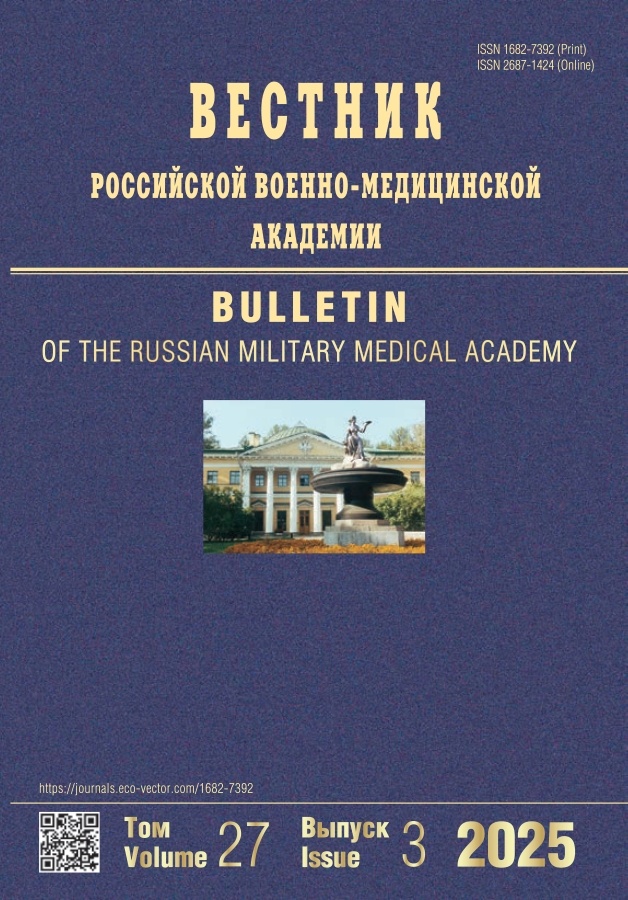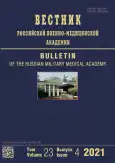Metabolic and anxiety-depressive disorders in patients with polymorbid cardiovascular disease
- 作者: Partsernyak A.S.1, Kryukov E.V.1, Tsygan V.N.1, Kurasov E.S.1, Ovchinnikov D.V.1
-
隶属关系:
- Military Medical Academy named after S.M. Kirov of the Ministry of Defense of the Russian Federation
- 期: 卷 23, 编号 4 (2021)
- 页面: 9-18
- 栏目: Clinical trials
- URL: https://journals.rcsi.science/1682-7392/article/view/63705
- DOI: https://doi.org/10.17816/brmma63705
- ID: 63705
如何引用文章
详细
The peculiarities of the influence of the metabolic disorders and depressive spectrum disorders in the development of polymorbid pathology are investigated. 160 male patients were examined, divided into three groups. The first group included 56 young men, 39–40.2 years old, body mass index 34.2–35 kg/m2, suffering from the polymorbid cardiovascular pathology, in which the presence of coronary heart disease, angina pectoris of the functional class I–II, arterial hypertension 2–3 degrees, obesity 1–2 degrees, depressive spectrum disorders was considered. The second group included 56 middle-aged men, 47.5–48.3 years old, body mass index 36.2–36.9 kg/m2 with a similar combination of diseases of the first group. The third (control group) included 48 young men, 39.6–40.9 years old, body mass index 24.1–24.9 kg/m2, suffering from the polymorbid cardiovascular pathology without the metabolic syndrome and obesity. The anthropometric status, glucose, insulin, total cholesterol, triglycerides, and low-density lipoproteins were assessed. Instrumental diagnostics of the coronary heart disease and hypertension was carried out, anxiety and depressive disorders were established based on the results of a questionnaire and a consultation with a psychiatrist. It was found that in a group of young and middle-aged patients suffering from the polymorbid cardiovascular pathology, in combination with a metabolic syndrome and depressive spectrum disorders, psychopathological disorders (borderline anxiety-depressive state) are associated with the metabolic disorders, high prevalence of pain-free form of myocardial ischemia and unfavorable variants of two-phase blood pressure rhythm during the day, according to the type of insufficient degree of reduction of nocturnal blood pressure — «non-dippers» and a steady increase in the night blood pressure — «night-peakers», which determines a high risk of cardiovascular complications.
作者简介
Alexander Partsernyak
Military Medical Academy named after S.M. Kirov of the Ministry of Defense of the Russian Federation
Email: partsernyak@mail.ru
ORCID iD: 0000-0002-9721-1319
SPIN 代码: 5829-1481
Scopus 作者 ID: 57217500920
candidate of medical science
俄罗斯联邦, Saint PetersburgEvgeny Kryukov
Military Medical Academy named after S.M. Kirov of the Ministry of Defense of the Russian Federation
Email: partsernyak@mail.ru
ORCID iD: 0000-0002-8396-1936
SPIN 代码: 3900-3441
doctor of medical sciences, professor
俄罗斯联邦, Saint PetersburgVasily Tsygan
Military Medical Academy named after S.M. Kirov of the Ministry of Defense of the Russian Federation
Email: partsernyak@mail.ru
SPIN 代码: 7215-6206
Scopus 作者 ID: 6603136317
doctor of medical sciences, professor
俄罗斯联邦, Saint PetersburgEvgeny Kurasov
Military Medical Academy named after S.M. Kirov of the Ministry of Defense of the Russian Federation
Email: partsernyak@mail.ru
SPIN 代码: 4961-0342
doctor of medical sciences
俄罗斯联邦, Saint PetersburgDmitrii Ovchinnikov
Military Medical Academy named after S.M. Kirov of the Ministry of Defense of the Russian Federation
编辑信件的主要联系方式.
Email: partsernyak@mail.ru
ORCID iD: 0000-0001-8408-5301
SPIN 代码: 5437-3457
Scopus 作者 ID: 36185599800
candidate of medical science, associate professor
俄罗斯联邦, Saint Petersburg参考
- Kenchaiah S. Obesity and the risk of heart failure. New England Journal of Medicine. 2002;347(5):305–313. doi: 10.1056/NEJMoa020245
- Kryukov EV, Orlov FA, Alatortseva IA. Klinicheskaya otsenka faktorov riska serdechno-sosudistykh oslozhneniy metodom matematicheskogo modelirovaniya u patsiyentov s raznymi geometricheskimi modelyami serdtsa. Sovremennyye problemy zdravookhraneniya i meditsinskoy statistiki. 2019;3:1–15. doi: 10.24411/2312-2935-2019-10051 (In Russ.).
- Reaven GM. Role of insulin resistance in human disease. Diabetes. 1988;37:1595–1607. doi: 10.2337/diab.37.12.1595
- Butrova SA. Metabolicheskiy sindrom: patogenez, klinika, diagnostika, podkhody k lecheniyu. Russkij medecinskij zurnal. 2001;9(2):56–60. (In Russ.).
- Gan Y, Gong Y, Tong X, et al. Depression and the risk of coronary heart disease: a meta-analysis of prospective cohort studies. BMC Psychiatry. 2014;14:371. doi: 10.1186/s12888-014-0371-z
- Wu Q, Kling JM. Depression and the risk of myocardial infarction and coronary death: a meta-analysis of prospective cohort studies. Medicine (Baltimore). 2016;95(6):2815. doi: 10.1097/MD.0000000000002815
- Nikitin AE, Shamrey VK, Kurasov ЕS. Mental disorders in young serviceman with cardiological emergencies. Russian Military Medical Journal. 2011;332(3):35–41. (In Russ.). doi: 10.17816/RMMJ75186
- Halaris A, Kemp AH, Dantas EM, Goulart AC, et al. Inflammation-associated co-morbidity between depression and cardiovascular disease. Cognitive, Affective & Behavioral Neuroscience. 2017;31: 45–70. doi: 10.1007/7854_2016_28
- Brunoni AR. Heart rate variability is a trait marker of major depressive disorder: evidence from the sertraline versus electric current therapy to treat depression clinical study. Int J Neuropsychopharmacol. 2013;16(9):1937–1949. doi: 10.1017/S1461145713000497
- Kop WJ, Phyllis KS, Russell PT, et al. Autonomic nervous system dysfunction and inflammation contribute to the increased cardiovascular mortality risk associated with depression. Psychosom Med. 2010;72(7):626–635. doi: 10.1097/PSY.0b013e3181eadd2b
- Cooper DC, Tomfohr LM, Milic MS, et al. Depressed mood and flow-mediated dilation: a systematic review and meta-analysis. Psychosom Med. 2011;73(5):360–369. doi: 10.1097/PSY.0b013e31821db79a
- Berntson J, Stewart KR, Vrany E, et al. Depressive symptoms and self-reported adherence to medical recommendations to prevent cardiovascular disease. Soc Sci Med. 2015;138:74–81. doi: 10.1016/j.socscimed.2015.05.041
- Sin NL, Kumar AD, Gehi AK, Whooley MA, et al. Direction of association between depressive symptoms and lifestyle behaviors in patients with coronary heart disease: the heart and soul study. Ann Behav Med. 2016;50(4):523–532. doi: 10.1007/s12160-016-9777-9
- Partsernyak SA. Prezhdevremennoye stareniye, polimorbidnost' i integrativnaya meditsina: napravleniye resheniy i deystviy. Saint Petersburg: Izdatel'stvo SZGMU im. II. Mechnikova; 2018. 330 p. (In Russ.).
- Lazebnik LB. Polimorbidnost' u pozhilykh. Serdtse. 2007;7: 25–27. (In Russ.).
- Barroso TA, Braga L, Alves MR, et al. Association of central obesity with the incidence of cardiovascular diseases and risk factors. Int J Cardiovasc Sci. 2017;30(5):416–424. doi: 10.5935/2359-4802.20170073
- Akil L, Ahmad HA. Relationships between obesity and cardiovascular diseases in four southern states and Colorado. J Health Care Poor Underserved. 2011;22(4):61–72. doi: 10.1353/hpu.2011.0166
- Endokrinologiya: natsional'noye rukovodstvo: kratkoye izdaniye. Dedov II, Mel'nichenko GA, editors. 2-ye izd., pererab. i dop. Moscow: GEOTAR-Media; 2020. 832 p. (In Russ.).
- Dolgov VV. Klinicheskaya laboratornaya diagnostika: natsional'noye rukovodstvo. Moscow: GEOTAR-Media; 2012. 928 p. (In Russ.).
- Kryukov ЕV, Potekhin NP, Fursov AN, et al. Evaluation of the effectiveness of antihypertensive therapy in patients with arterial hypertension and multifocal atherosclerosis. Military Medical Journal. 2020;341(4):66–67. (In Russ.).
- Montalescot G, Sechtem U, Achenbach S, et al. 2013 ESC guidelines on the management of stable coronary artery disease: the Task Force on the management of stable coronary artery disease of the European Society of Cardiology. Eur Heart J. 2013;34(38): 2949–3003. doi: 10.1093/eurheartj/eht296
- Timofeyev VI, Filimonenko YI. Kratkoye rukovodstvo prakticheskomu psikhologu po issledovaniyu tsvetovogo testa M. Lyushera. Izdaniye 3-ye, ispr. Moscow: Imaton; 1995. 29 p. (In Russ.).
- Sobchik LN. Standartizirovannyy mnogofaktornyy metod issledovaniya lichnosti SMIL. Saint Petersburg: Rech'; 2000. 219 p. (In Russ.).
- Spitzer RL, Kroenke K, Williams JB. Validation and utility of a self-report version of PRIME-MD: the PHQ primary care study. Primary Care Evaluation of Mental Disorders. Patient Health Questionnaire. JAMA. 1999;282:1737–1744. doi: 10.1001/jama.282.18.1737
- Kroenke K, Spitzer RL, Williams JBW. Anxiety disorders in primary care: prevalence, impairment, comorbidity, and detection. Ann Intern Med. 2007;146:317–325. doi: 10.7326/0003-4819-146-5-200703060-00004
- Rothwell PM, Howard SC, Dolan E. Prognostic significance of visit-to-visit variability, maximum systolic blood pressure, and episodic hypertension. Lancet. 2010;375(9718):895–905. doi: 10.1016/S0140-6736(10)60308-X
- Poulter NR, Wedel H, Dahlof B, et al. Role of blood pressure and other variables in the diff erential cardiovascular event rates noted in the anglo-scandinavian cardiac outcomes trial-blood pressure lowering arm (ASCOT-BPLA). Lancet. 2005;366:907–913. doi: 10.1016/S0140-6736(05)67186-3
- Koshlya VI, Martynenko AV. Silent myocardial ischemia in patients with diabetes mellitus type 2. Zaporozhye Medical Journal. 2015;(6):88–92. doi: 10.14739/2310-1210.2015.6.56304
- Elham M, Yousief MD, Kandeel AA, et al. Association of silent myocardial ischemia in obese patients with metabolic syndrome. A Med J Cairo Univ. 2020;88(2):661–666. doi: 10.21608/MJCU.2020.104620
- Protopopov VP. Somaticheskiy sindrom, nablyudayemyy v techeniye maniakal'no-depressivnogo psikhoza. Nauchnaya meditsina. 1920;7:721–749. (In Russ.).
补充文件








